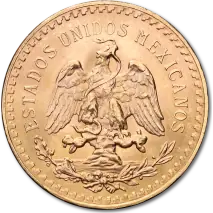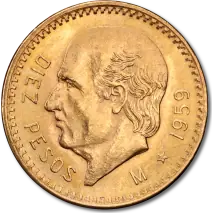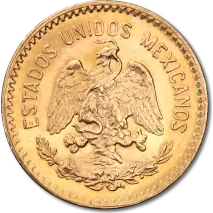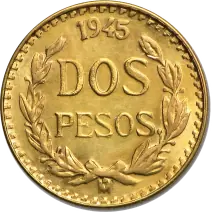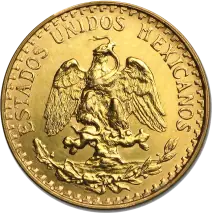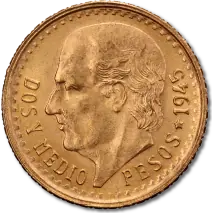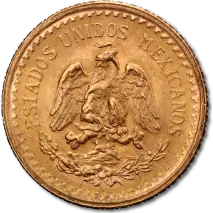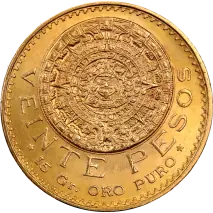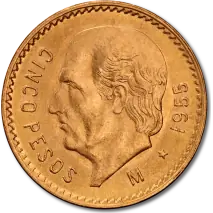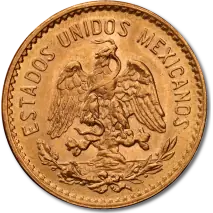Mexican Peso Gold Coins
Buy Mexican Peso gold coins in the UK
Invest in Mexican Peso gold coins with StoneXBullion, the leading platform for buying investment-grade gold bullion in the UK and Europe. Since 2006, we’ve helped more than 100,000 investors buy and sell gold online securely.
Our selection of gold Mexican Pesos are fully authenticated, competitively priced, and shipped with insured delivery across the UK and Europe.
What are Mexican Peso gold coins?
Mexican Peso gold coins are some of the most iconic historic bullion coins of the Americas, first issued in 1921 to commemorate the 100th anniversary of Mexico's independence from Spain. These were considered the purest gold coins in the world up until the release of the South African Krugerrand in 1967.
Key features of Mexican Peso coins:
- High purity: Mexican Pesos are struck in 90% gold (0.900 fineness) with 10% copper
- Multiple denominations: Including 50, 20, 10, 5, 2.5, and 2 pesos
- Historic designs: Featuring national symbols such as the Winged Victory, Mexico's coat of arms, and notable figures like Miguel Hidalgo
- Recognised worldwide: These coins are highly liquid and widely traded in global bullion markets.
Why invest in Mexican Peso gold coins?
Mexican Peso coins appeal to both investors and collectors thanks to their unique combination of gold content and historical significance:
- High gold content: Particularly the 50 Peso, which contains 37.5 grams of pure gold, making it one of the largest historic gold coins ever minted
- VAT-free in the UK: Peso coins are classed as investment-grade gold, making them exempt from VAT in the UK
- Strong liquidity: Widely recognised around the world and easy to resell
- Collectible interest: Different denominations, dates, and designs create an opportunity to build thematic collections.
Types of Mexican Peso coins
Our collection includes a full range of historic Peso denominations, all struck from 90% gold and 10% copper.
50 Peso Gold Coin - ‘Centenario’
The 50 Peso is the most famous Mexican gold coin.
- Pure gold content: 37.50 grams
- Design: Winged Victory on the obverse, national coat of arms on the reverse
- Ideal for: Investors seeking maximum gold content.
20 Peso Gold Coins - ‘Azteca’
These coins are known for their distinctive Aztec Calendar Stone design.
- Pure gold content: 15 grams
- Design: National shield on the obverse, Aztec Calendar on the reverse
- Ideal for: Collectors and mid-level investors.
10 Peso Gold Coins - ‘Hidalgo’
Featuring Mexican independence hero, Miguel Hidalgo.
- Pure gold content: 7.5 grams
- Ideal for: Beginner investors and gifting.
5, 2.5, and 2 Peso Gold Coins
These small, fractional coins are ideal for beginners.
- Pure gold content: 1.50 - 3.75 grams
- Ideal for: Incremental investing or building a full set.
How to buy Mexican Gold Pesos in the UK
Buying Mexican Peso coins with StoneXBullion is quick, safe, and secure:
- Browse our collection: Choose from 50, 20, 10, 5, 2.5, and 2 Peso gold coins
- Check live gold prices: Updated every 60 seconds based on the London Bullion Market Association (LBMA)
- Pay securely: Complete payment via bank transfer or credit card
- Receive insured delivery: Orders are discreetly packaged and fully insured for delivery across the UK and Europe.
Gold Mexican Pesos: FAQs
What is the purity of Mexican Peso coins?
Mexican Peso coins are struck from 90% pure gold and 10% copper for added durability.
Are Mexican Peso gold coins VAT-free in the UK?
Yes, Mexican Pesos are classed as investment-grade gold and VAT-free in the UK.
Which Mexican Peso coin is best for investors?
The most popular Mexican Peso amongst investors is the 50 Peso (Centenario) due to its large gold content.
Are Mexican Peso gold coins restrikes?
Yes, many Mexican Pesos minted after 1948 are restrikes made using original dies.
Are Mexican Peso coins easy to resell?
Yes, Mexican Pesos are widely recognised and traded by bullion dealers around the world.
Invest in Mexican Peso coins today
Buy Mexican Gold Peso coins online with StoneXBullion, trusted by more than 100,000 investors across the UK and Europe for nearly two decades. Enjoy competitive spreads, live pricing, and fully insured delivery direct to your door.
Browse all Mexican Gold Peso Coins and start your gold collection today.

